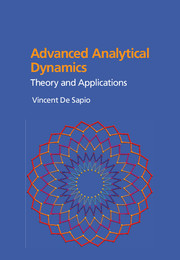Book contents
- Frontmatter
- Contents
- List of Illustrations
- List of Tables
- Preface
- Notation
- 1 Introduction
- 2 Mathematical Preliminaries
- 3 Kinematics of Discrete Systems
- 4 Conservation Principles
- 5 Zeroth-Order Variational Principles
- 6 First-Order Variational Principles
- 7 Second-Order Variational Principles
- 8 Dynamics in Task Space
- 9 Applications to Biomechanical Systems
- 10 Software for Analytical Dynamics
- Appendix Inclusion of Flexible Bodies
- References
- Index
7 - Second-Order Variational Principles
Published online by Cambridge University Press: 02 February 2017
- Frontmatter
- Contents
- List of Illustrations
- List of Tables
- Preface
- Notation
- 1 Introduction
- 2 Mathematical Preliminaries
- 3 Kinematics of Discrete Systems
- 4 Conservation Principles
- 5 Zeroth-Order Variational Principles
- 6 First-Order Variational Principles
- 7 Second-Order Variational Principles
- 8 Dynamics in Task Space
- 9 Applications to Biomechanical Systems
- 10 Software for Analytical Dynamics
- Appendix Inclusion of Flexible Bodies
- References
- Index
Summary
In the previous two chapters we addressed zeroth- and first-order variational principles. In this chapter we will focus on the second-order variation of displacement. We will begin with Gauss's Principle (Gauss 1829). The principle is based on the notion of virtual acceleration. The derivation of the equations of motion for particles and rigid bodies using Gauss's Principle closely parallels the derivation of the equations of motion using d'Alembert's Principle and Jourdain's Principle in the previous chapters. As with d'Alembert's and Jourdain's Principles, Gauss's Principle can be seen as an independent principle of analytical dynamics. Therefore, as with the previous chapters, this chapter is presented in a stand-alone manner.
Virtual Accelerations
Virtual accelerations refer to all accelerations of a system that satisfy the scleronomic constraints. In the case of virtual accelerations, time, position, and velocity are frozen or stationary.
Gauss's Principle
PRINCIPLE 7.1 The virtual acceleration work of a system is stationary. That is,
δA = 0.
Additionally, the constraints of the system generate no virtual acceleration work,
δAc = 0.
This is known as Gauss's Principle.
As with d'Alembert's Principle and Jourdain's Principle, it is noted that while Gauss's Principle can be seen as providing an alternate statement of Newton's second law, for interacting bodies, a law of action and reaction (Newton's third law) is still needed. Therefore, when we use Gauss's Principle to derive the equations of motion for systems of particles/bodies, we will invoke the law of action and reaction.
A Single Particle
Gauss's Principle for a single point mass with a discrete set of nf external forces, ﹛ f1, …, fnf ﹜, acting on it is expressed as
where δa represents the acceleration variations. During these variations, time, position, and velocity are stationary. That is, δt = 0, δr = 0, and δv = 0.
- Type
- Chapter
- Information
- Advanced Analytical DynamicsTheory and Applications, pp. 188 - 213Publisher: Cambridge University PressPrint publication year: 2017



